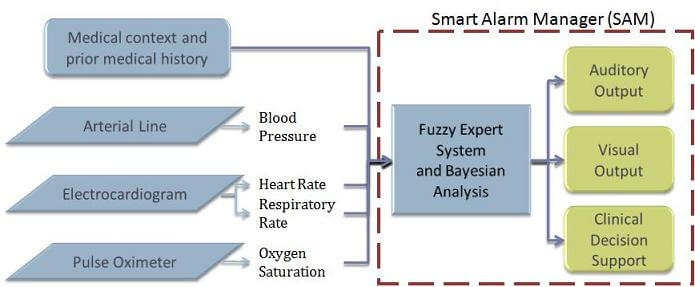The Intensive Care Unit of most major hospitals is a noisy environment. In order to monitor patients, healthcare practitioners set threshold alarms on each of many individual vital sign monitors. While nurses themselves rarely consider one vital sign in isolation, the current alarm algorithms elicit numerous false positive alarms by only examining each vital sign individually. The lack of clinical relevancy in a majority of these alarms produces an inefficient healthcare system, where nurses habitually ignore low level alarms
due to their overabundance.
The Smart Alarms project consists of an alarm algorithm that considers multiple vital signs when monitoring a post coronary artery bypass graft (post-CABG) surgery patient. The nature of this condition enables the
algorithm to focus on monitoring four vital signs: blood pressure, heart rate, respiration rate, and oxygen saturation rate. This solution constructs a new, three level alarm priority system that more efficiently communicates the clinical severity of the problem based on the needs and requests of current healthcare practitioners. As a result, this multivariate approach decreases clinical false alarms.
The algorithm takes the input of four vital signs from three monitors and employs a Fuzzy Expert System to mimic the decision processes of nurses. In addition, the algorithm includes a Clinical Decision Support tool that employs Bayesian theory to display the possible CABG-related complications the patient might be undergoing at any point in time, as well as the most relevant risk factors.
Objectives
- Develop an alarm algorithm that considers multiple vital signs when monitoring a post coronary artery bypass graft patient.
- Decrease the number of total alarms and of false alarms by vital sign monitors by 25% without creating additional false negatives. For the purposes of system validation in this project, false alarms are defined as those resulting in no clinical intervention.
- Create a new, three level alarm priority system that more efficiently communicates the clinical severity of the problem.
Why Coronary Artery Bypass Graft Surgery?
Attempting to reduce clinical alarms in all areas of patient care would be an in-depth, several-years long endeavor. Our decision to focus on post-coronary artery bypass graft (CABG) patients responded to:
- A need to narrow down our focus to a concrete clinical scenario.
- The well-researched nature of this procedure and its complications.
- The abundance of CABG surgeries in hospitals: 427,000 CABG surgeries are performed every year in the United States.
Other Members:
- Ana R. Giannareas
- Vanessa Kern
- Nicholas Stevens
- Adrian Viesca-Treviño
- Dr. John Keenan
- Margaret Fortino-Mullen, MSN, RNGroup
System Design
The Smart Alarm Manager was designed with the input of 7 experienced nurses from the Univ. of Penn Health System.
Nurses provided data for the design of:
- Vital sign fuzzy sets
- Alarm levels for critical scenarios
- List of relevant complications, associated vital sign behavior and likelihood ratios
- Preferences for visual and auditory alarms
System Validation
Penn Presbyterian Medical Center (PMC)
The Smart Alarm Manager was tested using retrospective vital sign and contextual data from de-identified PMC SICU patients. The data was obtained with expedited IRB approval of Protocol #811401.
PhysioNet
The system was also tested with clinical data provided by PhysioNet.org, an MIT databank.

